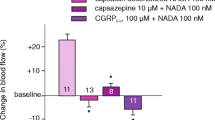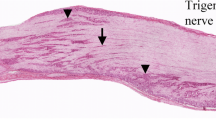Abstract
In this paper morphological and physiological experiments are described that refer to the concept of neurogenic inflammation of meningeal structures as a putative source of migrainous pain and other headaches. The main emphasis of this study carried out on the duramater encephali of the rat was the functional role of calcitonin generelated peptide (CGRP), a vasodilatory neuropeptide of fine afferent nerve fibres. Immunocytochemical preparations showed that the parietal dura mater was densely innervated by CGRP immunoreactive nerve fibres, the distribution and ultrastructure of which were examined by ligh and electron microscopy. The dense innervation around the medial meningeal artery suggested a vasomotor function of these peptidergic fibres. In further experiments the CGRP immune product of the nerve fibres could be diminished by electrical stimulation of the dura mater. Extracellular recordings from trigeminal ganglion cells showed that electrical and mechanical stimulation of large dural vessels activate trigeminal afferents. In a final series of experiments the dural blood flow around branches of the medial meningeal artery was measured with a laser Doppler flowmeter. The blood flow was increased by electrical stimulation of the dura, the size of this effect depending on stimulus strength and frequency. This increase was inhibited in a dose-dependent manner by the competitive CGRP antagonist CGRP8–37, which shows an involvement of CGRP in the regulation of meningeal blood flow. We conclude that stimulation of trigeminal afferents innervating the dura mater releases CGRP from peptidergic afferent terminals, thereby causing vasodilatation and increasing the meningeal blood flow, an important component of neurogenic inflammation. The preparation decribed will be used for further studies on basic mechanisms of neurogenic inflammation and nociception in meningeal structures.
Zusammenfassung
Die vorliegende Arbeit beschreibt Experimente zur neurogenen Entzündung der Hirnhäute, die als Ursache des Migräneschmerzes und anderer Kopfschmerzformen diskutiert wird. Die Arbeit umfaßt ein Spektrum struktureller und funktioneller Untersuchungen an der Dura mater encephali der Ratte. Im Mittelpunkt steht dabei das “calcitonin gene-related peptide” (CGRP), ein vasodilatorisch wirkendes Neuropeptid afferenter Nervenfasern, das an neurogenen Entzündungsvorgängen maßgeblich beteiligt zu sein scheint. Mit immunzytochemischen Methoden wurde zunächst die Verteilung und die Struktur der CGRP-positiven Nervenfasern in der Dura mater licht- und elektronenmikroskopisch dargestellt. Die dichte CGRP-immunreaktive Innervierung im Stromgebiet der Arteria meningea media deutete auf eine Beteiligung dieser Nervenfasern an vasomotorischen Reaktionen hin. Durch elektrische Stimulierung der Dura mater konnte das sichtbare CGRP-Immunprodukt der Nervenfasern in Abhängigkeit von der Reizdauer vermindert werden. Erste elektrophysiologische Ableitungen aus dem Ganglion trigeminale zeigten, daß durch elektrische und mechanische Stimulierung großer Hirnhautgefäße afferente Fasern des trigeminalen Systems erregt werden können. In einer letzten Experimentfolge wurde mit einem Laser-Doppler-Flowmeter die Durchblutung der Dura mater registriert. Der Blutfluß konnte durch elektrische Stimulierung reizstärken- und frequenzabhängig gesteigert werden. Diese evozierte Blutflußerhöhung wurde dosisabhängig durch den kompetitiven CGRP-Antagonisten CGRP8–37 gehemmt, was die Beteiligung von CGRP an der Steuerung der Hirnhautdurchblutung nahelegt. Die Experimente lassen darauf schließen, daß durch eine Aktivierung trigeminaler Afferenzen der Dura mater das Neuropeptide CGRP aus afferenten Nervenendigungen freigesetzt wird und die Vasodilatation, eine wichtige Komponente der neurogenen Entzündung, verursacht. Das beschriebene Präparat soll zur weiteren Aufklärung neurogener Entzündungsvorgänge und nozizeptiver Mechanismen in den Hirnhäuten verwendet werden.
Similar content being viewed by others
Literatur
Andersson SE (1989) Effects of intravenous calcitonin gene-related peptide (CGRP) on local blood flow in the cat. Acta Physiol Scand 137:259
Bill A, Stjernschantz J, Mandahl A, Brodin E, Nilsson G (1979) Substance P: release on trigeminal nerve stimulation, effects in the eye. Acta Physiol Scand 106:371
Brain SD, Williams TJ, Tippins JR, Morris HR, MacIntyre I (1985) Calcitonin gene-related peptide is a potent vasodilator. Nature 313:54
Buzzi MG, Carter WB, Shimizu T, Heath HG, Moskowitz MA (1991) Dihydroergotamine and sumatriptan attenuate levels of CGRP in plasma in rat superior sagittal sinus during electrical stimulation of the trigeminal ganglion. Neuropharmacology 30:1193
Dimitriadou V, Buzzi MG, Moskowitz MA, Theoharides TC (1991) Trigeminal sensory fiber stimulation induces morphological changes reflecting secretion in rat dura mater mast cells. Neuroscience 44:97
Dimitriadou V, Buzzi MG, Theoharides TC, Moskowitz MA (1992) Ultrastructural evidence for neurogenically mediated changes in blood vessels of the rat dura mater and tongue following antidromic trigeminal stimulation. Neuroscience 48:187
Drummond PD, Lance JW (1983) Extracranial vascular changes and the source of pain in migraine headache. Ann Neurol 13:32
Düring M von, Bauersachs M, Böhmer B, Veh RW, Andres KH (1990) Neuropeptide Y-and substance P-like immunoreactive nerve fibers in the rat dura mater encephali. Anat Embryol (Berl) 182:363
Ferrell WR, Russel NJW (1986) Extravasation in the knee induced by antidromic stimulation of articular C fibre afferents of the anaesthetized cat. J Physiol 379:407
Friberg L (1991) Cerebral blood flow changes in migraine: methods, observations and hypotheses. J Neurol 238:S12
Friberg L, Olesen J, Iversen HK, Sperling B (1991) Migraine pain associated with middle cerebral dilatation: reversal by sumatriptan. Lancet 338:13
Geppetti P, Del Bianco E, Santicioli P, Lippe I, Maggi CA, Sicuteri F (1990) Release of sensory neuropeptides from dural venous sinuses of guinea pig. Brain Res 510:58
Goadsby PJ (1993) Inhibition of calcitonin gene-related peptide by h-CGRP(8–37) antagonizes the cerebral dilator response from nasociliary nerve stimulation in the cat. Neurosci Lett 151:13
Goadsby PJ, Edvinsson L, Ekman R (1988) Release of vasoactive peptides in the extracerebral circulation of humans and the cat during activation of the trigeminovascular system. Ann Neurol 23:193
Goadsby PJ, Edvinsson L, Ekman R (1990) Vasoactive peptide release in the extracerebral circulation of humans during migraine headache. Ann Neurol 28:183
Green PG, Basbaum AI, Levine JD (1992) Sensory neuropeptide interactions in the production of plasma extravasation in the rat. Neuroscience 50: 745
Hardebo JE (1990) On pain mechanisms in cluster headache. Headache 31:91
Jancsó N, Jancsó-Gábor A, Szolcsányi J (1967) Direct evidence for neurogenic inflammation and its prevention by denervation and by pretreatment with capsaicin. Br J Pharmac Chemother 31: 138
Keller JT, Marfurt CF (1991) Peptidergic and serotoninergic innervation of the rat dura mater. J Comp Neurol 309: 515
Kenins P (1981) Identification of the unmyelinated sensory nerves which evoke plasma extravasation in response to antidromic stimulation. Neurosci Lett 25:137
Lam FY, Ferrell WR (1991) Specific neurokinin receptors mediate plasma extravasation in the rat knee joint. Br J Pharmacol 103:1263
Lembeck F, Holzer P (1979) Substance P as neurogenic mediator of antidromic vasodilatation and neurogenic plasma extravasation. Naunyn-Schmiedebergs Arch Pharmacol 310:175
Markowitz S, Saito K, Moskowitz MA (1987) Neurogenically mediated leakage of plasma protein occurs from blood vessels in dura mater but not brain. J Neurosci 7:4129
McCulloch J, Uddman R, Kingman TA, Edvinsson L (1986) Calcitonin gene-related peptide: functional role in cerebrovascular regulation. Proc Natl Acad Sci USA 83:5731
Meßlinger K, Hanesch U, Baumgärtel M, Trost B, Schmidt RF (1993) Innervation of the dura mater encephali of cat and rat: ultrastructure and calcitonin gene-related peptide-like and substance P-like immunoreactivity. Anat Embryol (Berl) 188:219
Moskowitz MA (1984) The neurobiology of vascular head pain. Ann Neurol 16:157
Moskowitz MA (1993) Neurogenic inflammation in the pathophysiology and treatment of migraine. Neurology 43: S16
Olesen J (1978) Some clinical features of the acute migraine attack. An analysis of 750 patients. Headache 118:268
Olesen J (1991) Clinical and pathophysiological observations in migraine and tension-type headache explained by integration of vascular, supraspinal and myofascial inputs. Pain 46:125
Olesen J, Friberg L, Olsen TS, Iversen HK, Lassen NA, Andersen AR, Karle A (1990) Timing and topography of cerebral blood flow, aura, and headache during migraine attacks. Ann Neurol 28:791
Raskin NH (1981) Chemical headaches. Annu Rev Med 32:63
Ray BS, Wolff HG (1940) Experimental studies on headache. Arch Surg 41:813
Suzuki N, Hardebo JE, Kahrström J, Owman C (1990) Effect on cortical blood flow of electrical stimulation of trigeminal cerebrovascular nerve fibres in the rat. Acta Physiol Scand 138:307
Yaksh TL (1988) Substance P release from knee joint afferent terminals: modulation by opioids. Brain Res 458: 319
Author information
Authors and Affiliations
Additional information
Herrn Professor R. F. Schmidt für 20 Jahre Schmerzforschung gewidmet
Rights and permissions
About this article
Cite this article
Meßlinger, K., Hanesch, U. Calcitonin gene-related peptide immunreaktive Nervenfasern in der Dura mater encephali der Ratte. Schmerz 9, 20–28 (1995). https://doi.org/10.1007/BF02530381
Received:
Accepted:
Issue Date:
DOI: https://doi.org/10.1007/BF02530381
Key words
- Dura mater encephali
- Trigeminal afferents
- Peptide release
- CGRP
- Neurogenic inflammation
- Meningeal bloodflow
- Headache




